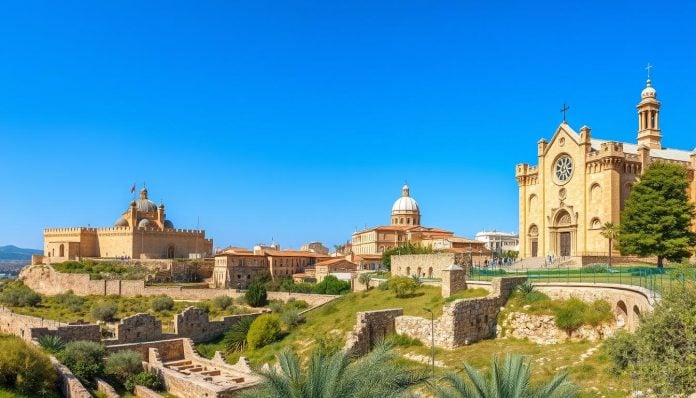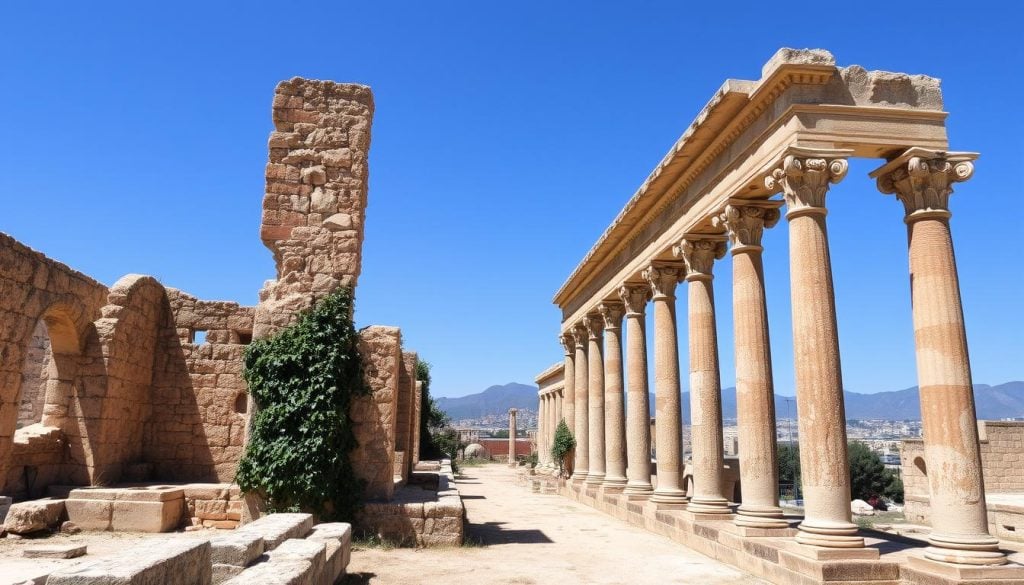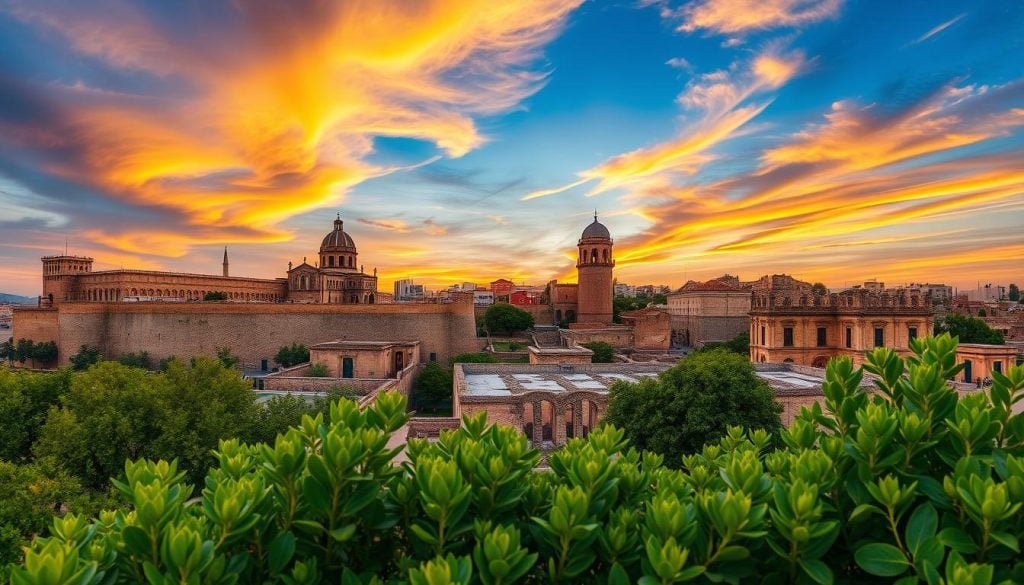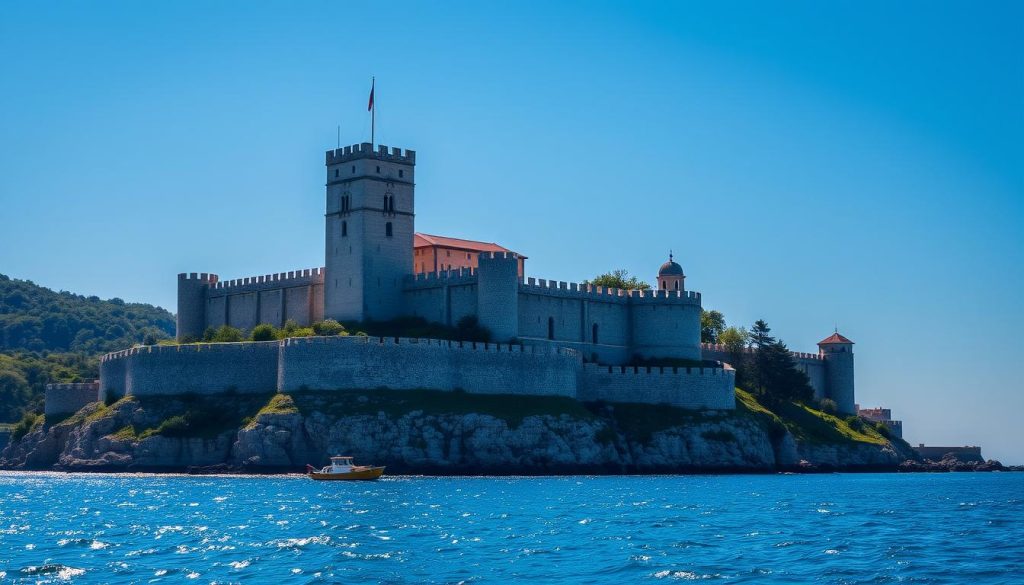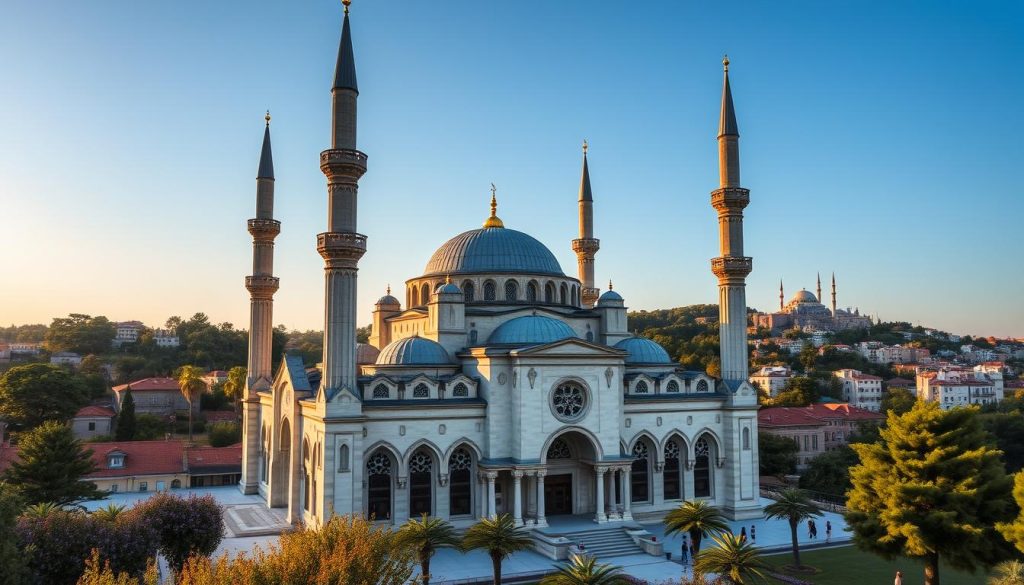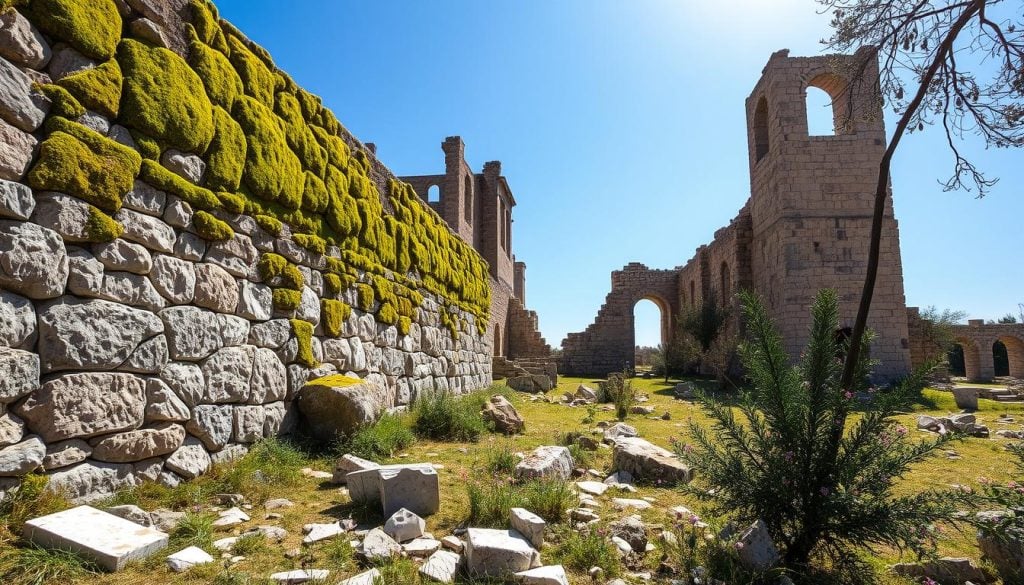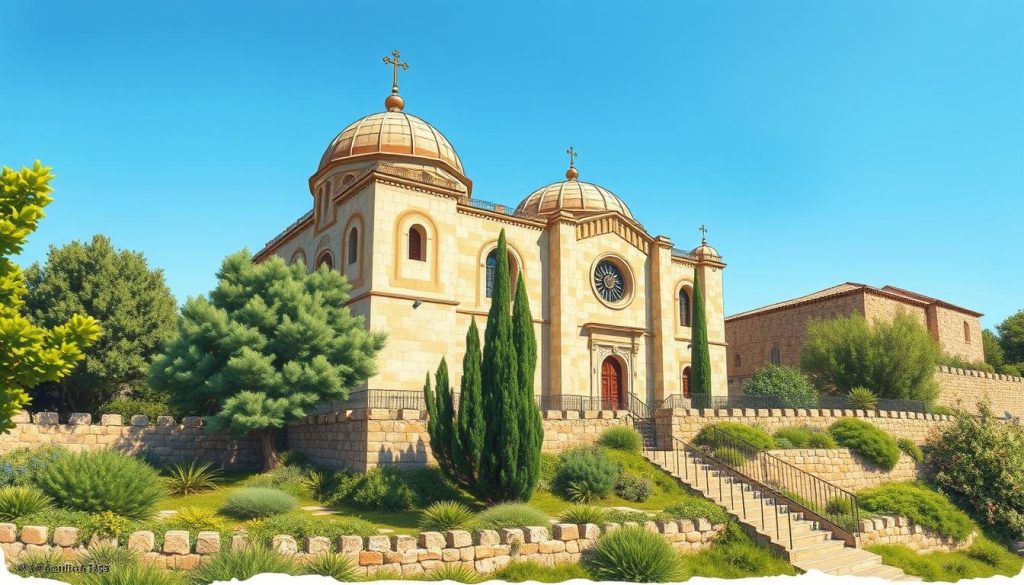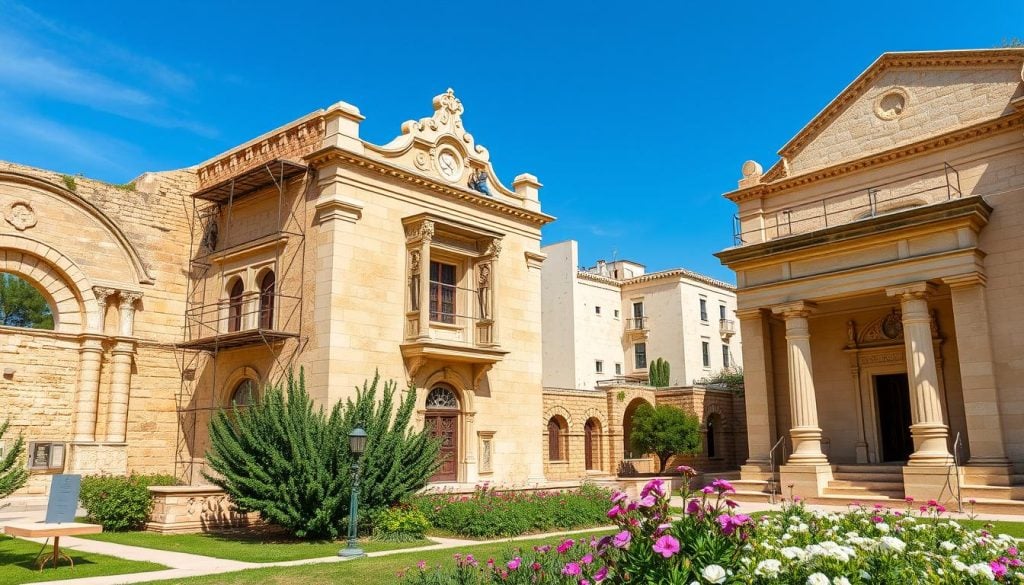Ever wondered what secrets Famagusta’s ancient walls hold? This city on Cyprus’s east coast is rich in history. It’s not just ruins; it’s a treasure trove of landmarks and cultural sites waiting to share their stories.
Othello Castle and St. Nicholas Cathedral are just a few highlights. These sites reflect the city’s Greek, Roman, and Ottoman past. Dive into Famagusta’s vibrant history and see how it has shaped the region over time.
Understanding the Historical Significance of Famagusta
Famagusta is a city that shows the mix of history and culture. It became a key trading center after Acre fell in 1291. It was as important as Constantinople and Venice. The historical importance of Famagusta grew as it was ruled by Greeks, Romans, Venetians, and Ottomans.
These rulers left their mark on the city’s buildings. The Cathedral of St. Nicholas is a prime example. It’s not just a beautiful building but also a part of the city’s story. It was where Crusader Jerusalem kings were crowned.
But Famagusta’s glory days were followed by decline, especially after the Ottoman siege in 1571. This siege changed the city’s life and led to its decline. Today, Famagusta shows both its grand past and its losses.
Famagusta Historic Landmarks: A Journey Through Time
Exploring Famagusta’s history is like looking at a rich tapestry. It shows the city’s growth from a medieval trade center to today. Many historic landmarks tell the story of this ancient city.
Timeline of Historical Events
Famagusta’s history is filled with key moments. These include:
- Establishment as a key trade hub in the medieval era
- Construction of the city walls by the Lusignans and Venetians
- Ottoman siege impacting the city’s governance
- British administration leading to contemporary divisions
Each event helped shape the city’s ruins. They show how different rulers changed its architecture and design.
Influences of Various Cultures
The buildings in Famagusta show the city’s diverse history. You can see Gothic and Venetian styles. This mix of cultures makes the city’s landscape unique.
| Culture | Architectural Style | Key Features |
|---|---|---|
| Lusignans | Gothic | Pointed arches, ribbed vaulting |
| Venetians | Renaissance | Fortified structures, ornate facades |
| Ottomans | Islamic | Minarets, intricate tile work |
This mix of cultures is a big part of Famagusta’s history. It shows how past influences still shape its landmarks today.
Exploring the Gorgeous Walled City of Famagusta
The Walled City of Famagusta is a stunning place that draws in visitors with its rich history and beautiful buildings. As you walk through, you see how Renaissance and Gothic styles blend together. This mix shows the city’s varied past, shaped by different rulers over time.
Architecture and Design Elements
The buildings here are filled with intricate details, some of the best in Famagusta. You’ll see symmetrical designs and beautiful stone work typical of Renaissance style. Gothic features like tall arches and ribbed vaults add to the mix, making it a unique sight. Looking at the grand facades and detailed doorways, you get a glimpse of the city’s artistic past.
Significance of the City Walls
The city walls of Famagusta are a major landmark. These strong walls, over two kilometers long, protected the city from invaders for centuries. Walking the walls, you get amazing views of the area, showing their strategic value. The walls are not just a sign of military skill but also of Famagusta’s lasting history.
| Element | Description | Historical Significance |
|---|---|---|
| City Walls | Fortified structures encircling the city | Protection against invasions; symbol of strength |
| Architectural Styles | Renaissance and Gothic influences | Representation of cultural fusion across eras |
| Narrow Streets | Twisting corridors lined with historic buildings | Offer insights into daily life and trade in the past |
| Ramparts | High walls providing elevated views | Strategic military vantage points and tourist attraction |
Othello Castle: The Iconic Fortress of Famagusta
Othello Castle, once known as the Castle of Famagusta, is a key part of the city’s history. The Venetians built it in the 15th century. It has high walls and structures that are still in good shape today.
Its design shows its importance as a fortress. It has strong architecture and defense systems.
The name “Othello” comes from Shakespeare’s play, set in this place. Walking through Othello Castle, you’ll see dungeons and battlements. Each part tells a story from the past.
The views of Famagusta from the castle are stunning. This makes it a top spot to visit in Famagusta.
History buffs will love the guided tours here. They explore the castle’s role in wars and its architectural changes. Othello Castle is a unique and grand treasure in Famagusta.
Unveiling the St. Nicholas Cathedral
Exploring Famagusta’s historic sites, St. Nicholas Cathedral is a standout. Now known as Lala Mustafa Pasha Mosque, it boasts Gothic elements that inspire awe. Its soaring arches and detailed craftsmanship highlight its importance in Famagusta’s cultural heritage.
Cathedral’s Architectural Features
The cathedral’s facade is adorned with intricate carvings, making its entrance striking. Inside, the high ceilings and expansive nave reflect its grandeur. The stained glass windows add vibrant colors, enhancing the atmosphere. These features not only beautify the space but also symbolize its spiritual significance.
Historical Importance as a Coronation Site
St. Nicholas Cathedral was more than just a beautiful building. It was the coronation site for the kings of Crusader Jerusalem. This makes it a key historical site in Famagusta. Visiting this landmark offers a glimpse into the city’s rich cultural heritage.
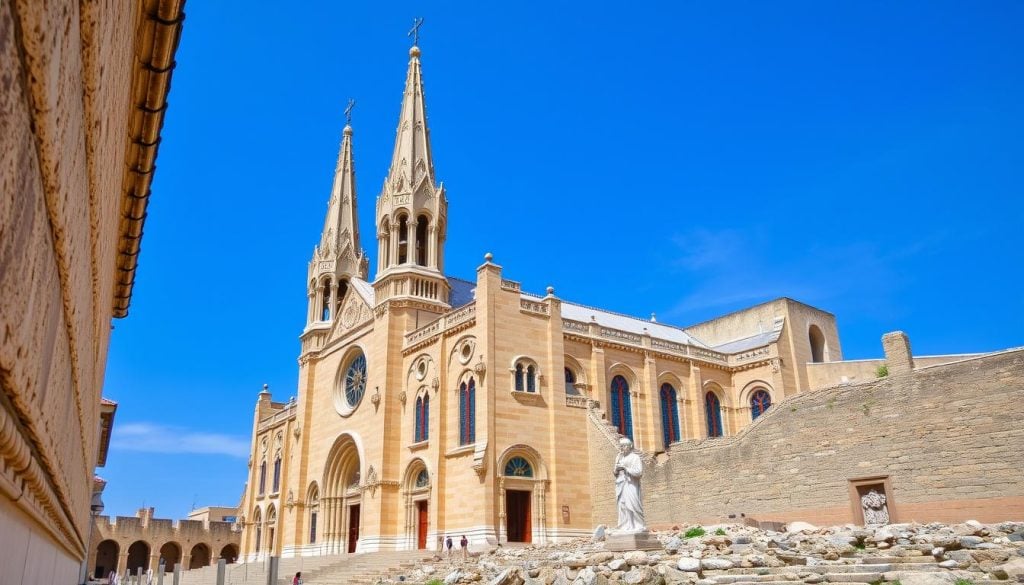
Discovering Lala Mustafa Pasha Mosque
The Lala Mustafa Pasha Mosque is a key part of Famagusta’s rich history. It was once a cathedral, showing off Gothic details that bring medieval charm to life.
When you step inside, you’ll see the impressive Moorish arches. They stand tall, contrasting with the detailed decorations inside. The large prayer areas offer a calm space, perfect for reflection.
This mosque is a major site in Famagusta, telling the tale of a city caught between cultures. Its design mixes Gothic and Ottoman styles, showing the city’s changing history. This blend of styles adds to its beauty and tells of Famagusta’s cultural evolution.
| Feature | Description |
|---|---|
| Architectural Style | Combination of Gothic and Ottoman influences |
| Interior Design | Moorish-style arches and ornate decorations |
| Significance | Mark of cultural transformation in Famagusta |
| Visitor Experience | Peaceful atmosphere ideal for reflection |
The Lala Mustafa Pasha Mosque is more than a place of worship. It’s a symbol of Famagusta’s rich heritage. It invites visitors to explore the complex history and culture it embodies.
The Enigmatic Ghost Town of Varosha
Varosha is a key part of Famagusta’s story. It was once a lively tourist spot but now lies abandoned. Nature is slowly taking over, with old hotels and homes standing as reminders of the past. Visiting these places makes you think deeply about what happened.
The Ghost Town’s Abandoned Structures
Varosha is filled with empty buildings that show its former glory. Each one tells a story of a community that once thrived. Some notable sights include:
- Luxury Hotels: These hotels were once loved by travelers but now show the effects of time.
- Residential Areas: Empty apartments and homes show the sudden loss of a community.
- Commercial Buildings: Shops and businesses that served visitors now slowly decay.
The Influence of the 1974 Conflict
The 1974 Turkish invasion of Cyprus changed Varosha forever. It was abandoned right after. This event has had a lasting effect on the area. Knowing about this helps you understand Famagusta’s ancient ruins and Cyprus’s history better. Varosha’s story of loss and politics is a big part of Famagusta’s history.
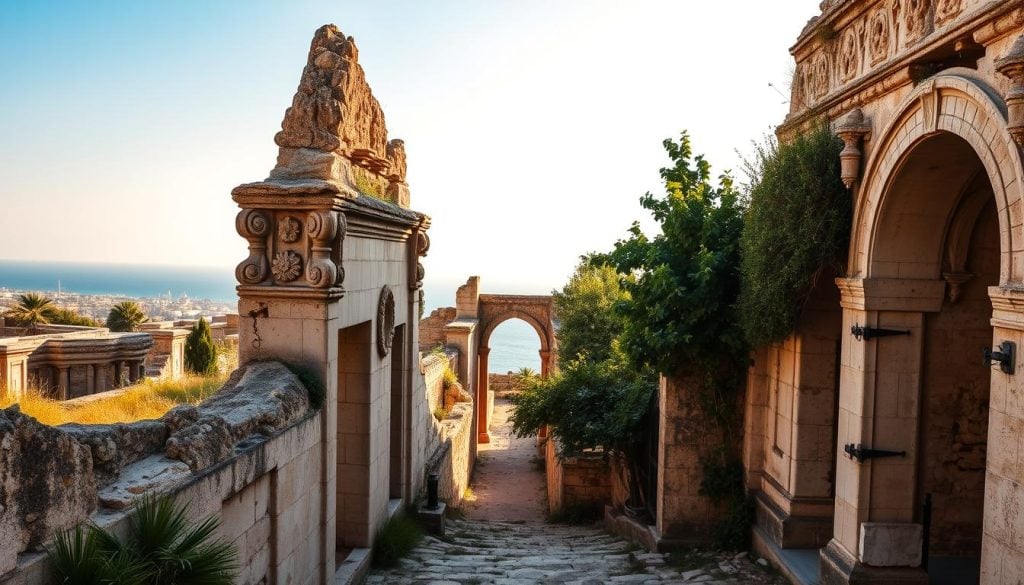
Famagusta Ancient Ruins: A Glimpse into the Past
The Famagusta ancient ruins offer a fascinating glimpse into the city’s rich history. Sites like the Roman amphitheater show the grandeur of past events. This structure was a key spot for entertainment, highlighting the city’s lively culture.
Among the famous landmarks in Famagusta, ancient churches and buildings stand out. They show the area’s prosperity in the past. These ruins also reflect the *Greek and Roman influences* that shaped the region’s culture. Walking through these sites lets you feel the echoes of the past.
Exploring the Famagusta ancient ruins deepens your understanding of the city’s history. You’ll see how ancient heritage connects to today’s culture. Each site shares a part of Famagusta’s story, inviting you to uncover its unique identity.
| Site | Description | Historical Significance |
|---|---|---|
| Roman Amphitheater | A large arena used for plays and events | Reflects the entertainment culture of ancient Famagusta |
| Ancient Churches | Remains of early Christian architecture | Signifies the city’s trade and cultural influences |
| Public Buildings | Ruins of ancient administrative structures | Highlights governance and community life |
St. Barnabas Monastery and Icon Museum: Cultural Treasures
The St. Barnabas Monastery and Icon Museum is a key part of Famagusta’s spiritual history. It honors Cyprus’s patron saint, showing the island’s diverse faiths. Here, you’ll see ancient relics and beautiful artworks that highlight the area’s cultural past.
Religious Artifacts and Icons
The museum displays many religious items from Famagusta, including stunning Byzantine icons. These icons show great skill and spiritual depth. Each one shares a story, revealing the community’s faith and history.
The icons’ detailed designs and bright colors are truly captivating. They pull you into the stories they tell, offering a glimpse into the spiritual world.
Significance in Cyprus’ Religious Heritage
This monastery is more than just a beautiful building; it’s a vital part of Famagusta’s cultural heritage. It showcases the blend of different faiths, enriching your view of Cyprus’s identity. Visiting St. Barnabas Monastery lets you see how faith has influenced culture over time.
The Impact of Conservation Efforts on Famagusta’s Heritage
Conservation efforts in Famagusta are crucial for protecting the city’s rich history. Many projects work to restore important buildings. They aim to keep the area’s integrity and grow public love for its cultural heritage.
Preservation Projects and Their Importance
Many preservation projects are underway in Famagusta. They focus on fixing old buildings and archaeological sites that show the city’s varied history. By restoring these sites, the community aims to keep Famagusta’s historic landmarks true to their original form.
For example, the St. Barnabas Monastery restoration shows the dedication to preserving Famagusta’s architectural heritage.
Role of Local and International Organizations
Local groups and international organizations work together to protect Famagusta. Their partnership brings in funding and shares knowledge. Organizations and governments highlight the need for preservation.
This awareness encourages everyone to help protect Famagusta’s cultural treasures. It makes the community feel responsible for keeping these landmarks safe.
Visiting Famagusta: A Guide for Travelers
Thinking about visiting Famagusta? Knowing how to get around makes your trip better. This guide will kickstart your journey through history and culture. Famagusta’s past and present make it a top spot for travelers.
How to Get There
Famagusta is about 44 kilometers southwest of Larnaca International Airport. You can drive or take a taxi there. Remember to check travel rules, as border crossings need the right papers.
Best Times to Visit
Spring or fall are the best times to see Famagusta. The weather is nice, perfect for exploring. You’ll enjoy the architecture and culture more in these seasons.
| Season | Temperature (°F) | Visitor Experience |
|---|---|---|
| Spring | 60-75 | Ideal for exploring landmarks and outdoor activities. |
| Summer | 75-90 | Hot weather; best for beach activities and nightlife. |
| Fall | 65-80 | Comfortable for tourism; fewer crowds. |
| Winter | 50-65 | Cooler; less ideal for outdoor activities, but peaceful. |
This travel guide Famagusta prepares you for a great visit. You’ll dive into the city’s history and beauty.
Conclusion
Your journey through Famagusta’s historic landmarks shows a city rich in history and beauty. Varosha, once lively, now has a haunting charm. The walled city’s impressive structures tell stories of resilience and change.
Every landmark, like Othello Castle and St. Nicholas Cathedral, reminds us of the past. They show the strong spirit of its people. These sites are a window into a world that once was.
Make sure to see Famagusta’s must-visit landmarks. They show the mix of cultures over the years. The work to save these places shows a dedication to keeping them for the future.
Exploring Famagusta is like stepping into a museum. It invites you to connect with its deep history. This city is a treasure trove of stories and beauty.
Famagusta is a symbol of heritage and the stories in its buildings. It’s perfect for history lovers or those looking for new places. Famagusta offers a journey through time, celebrating its past and looking forward to the future.

































